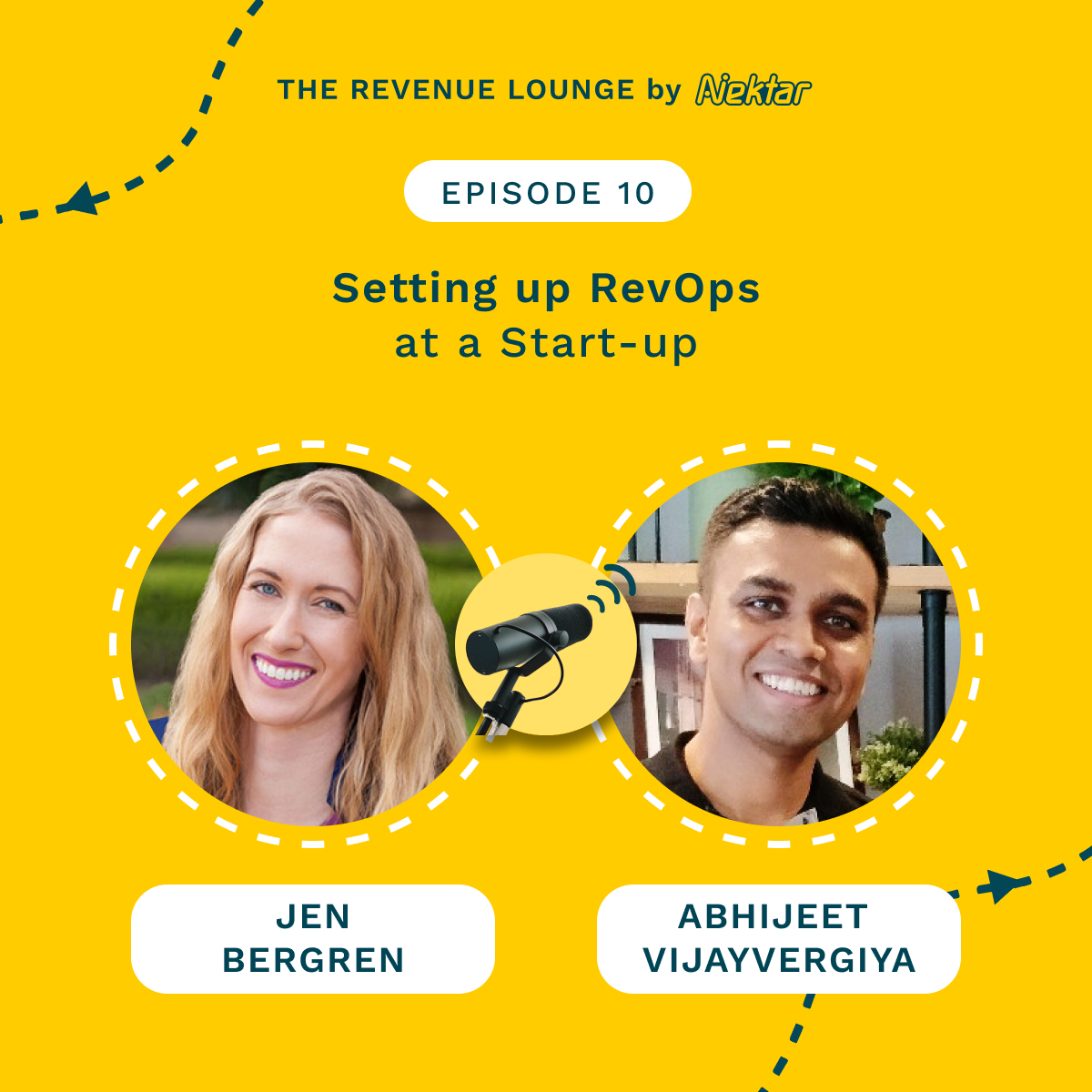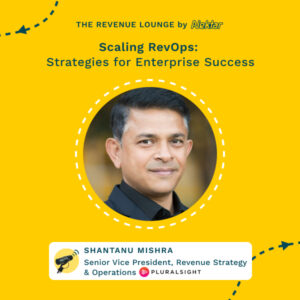Unlocking the Power of Buying Committees ft. Nandini Karkare
May 1, 2024
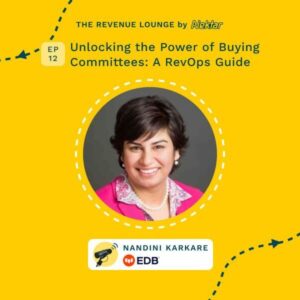
About
The Revenue Lounge
The podcast covers stories from leaders across RevOps, Sales, Customer Success, GTM, Data and Marketing about what drives these functions and what advice they would share with our listeners. With 3 seasons recorded, the podcast currently features 50+ enterprise leaders in the B2B SaaS domain. Tune in to hear from the best in the business
In this episode of the Revenue Lounge podcast, host Randy Likas talks with Nandini Karkare, Chief of Staff at EDB, about strategies and best practices for mastering buying committees in B2B organizations. They discuss the importance of capturing buying committee data, unlocking it from sales reps and making it accessible across teams, and using it to expand accounts and grow revenue over time.
Key Discussion Points:
– The pivotal role of capturing buying committee members to understand influence and priorities (00:04:21)
– Best practices for unlocking buying committee data from sales reps and centralizing it (00:06:55)
– Using buying committee insights across marketing, sales, and customer success for account growth (00:10:43)
– Transitioning buying committee data to renewal and expansion committees post-sale (00:18:16)
– The opportunities for AI and machine learning to add efficiency for overloaded revenue ops teams (00:23:34)
Guest Bio:
Nandini Karkare is the Chief of Staff at EDB and heads strategic initiatives to drive profitable growth. She has over 15 years of experience in revenue operations roles at EDB.
Company Bio:
EDB is a leading provider of enterprise-class software and services enabling organizations to harness the power of Postgres, the world’s most popular open source database.
Key Quotes:
“The next step of evolution as far as where I stand is who are the people that we need to speak to? And people are the most agile commodity in an organization.” (00:05:21)
“If you have one or the other, just one or the other, the whole deal collapses.” (00:14:26)
“It becomes you bring people along, and that’s the realization when we’ve, that’s nirvana, when you understand that it’s a team sport.” (00:21:15)

[00:00:00] In today’s business environment, B2B buying is never just one person. According to Forrester research, more than half of global business buyers purchase in complex buying scenarios that include more people, more departments, and generally higher price points. And this group can be made up of anywhere from seven to 20 people.
[00:00:19] Unlocking the power of buying committees is a crucial aspect of the B2B landscape. Join us as we navigate through the realms of derivative operations and uncover the strategies, insights, and best practices that constitute a comprehensive guide. To mastering the dynamics of buying committees. Hello everyone.
[00:00:34] Welcome to the revenue lounge podcast. I am your host, Randy Likas, and joining me today is Nandini Karkare. Nandini is the revenue leader who heads EDB’s strategic initiatives to ensure profitable growth and execution of velocity with a customer centric approach. Hi Nandini, thank you for joining us today.
[00:00:53] Hi Randy, thank you for having me here. Yeah, I’m very excited to have this conversation with you and appreciate your time. , so [00:01:00] why don’t we start. Maybe you could talk to me a little bit about your role, and your experience, , over the past several years at EDB.
[00:01:06] Okay. , my role today is that of chief of staff, but let me give you a little background of what Rev Ops has to do with Chief of staff here. So, I joined EDB in 2008 when EDB was pretty much a startup. EDB today is the leading provider of enterprise class software and services. Enabling organizations to harness the full power of Postgres.
[00:01:32] Postgres is the leading open source database, voted as the most popular and the most admired and desired database by developers, according to the Stack Overflow, survey.
[00:01:49] Since 2008, I’ve worked closely with the CFO, CRO, CMO, and the company’s CEO to deliver business insights and [00:02:00] have built business processes, systems, and teams to deliver those outcomes efficiently. You could call these moments that matter for our business through this journey and by building operational and analytical capabilities in EDB, I eventually became the Senior Vice President of Revenue Operations at EDB.
[00:02:24] Today, in my role as Chief of Staff to the CEO, a role I said yes to when the company was going through a leadership transition. Kevin Dallas, our CEO today, joined EDB back in August 2023, taking over from Ed Boyajian, who is EDB’s CEO for 15 years and now a board member. In my role as Chief of Staff, I play a multifaceted role, being the strategic advisor to the CEO and the leadership team.
[00:02:56] Prioritizing initiatives that align to the, our [00:03:00] vision and mission, liaising external communication and bringing about organizational alignment. I still, however, continue to be highly dialed in into the go to market efficiencies and ensure we as a company are customer centric. So this is my love for revenue operations and take saying yes to a role that is of chief of staff that I have, that I land here at EDB.
[00:03:27] Thank you. Well, I think it’s outstanding to see, someone who has been growing up in revenue operations or have a lot of experience get to a role where they’re advising a CEO. I think it speaks wonders to not only EDB, but also yourself about the importance now of revenue operations and strategy.
[00:03:44] And in the future of business. So that’s a great background. I appreciate you running through that with us. I have a question for you around the topic that we will be discussing today, which is around buying committees. And you know, when we speak with rev ups leaders like yourselves, they will often [00:04:00] say something to the effect of Capturing revenue, buying committees is really, really hard, right?
[00:04:05] It’s hard because, there’s lots of people. , we don’t always, document them, , correctly. It’s hard to understand the influence of each person, but I would just love to get your perspective on that. So maybe share your insights on what is that pivotal role , of capturing buying committee members, both from a contact perspective, like who these people are, But also the activity or the role that they play on and that opportunities themselves.
[00:04:29] Yeah. Such an important role, especially , when we sell to enterprises B2B, you know, it’s not a single person, it’s a buying committee, especially in this time where every dollar spent has to result in productivity and efficiency. It. goes through multiple layers of approval. People come together as a buying committee.
[00:04:50] As we’ve evolved in our approach of who we sell to understanding our target market, understanding which companies, , what do they look like? What are the personas that we should [00:05:00] be talking to? All of that evolution has happened. The next step of evolution as far as Where I stand is who are the people that we need to speak to and people are the most agile commodity In an organization call it maybe commodity is a bad word Not the best word but talent moves talent is agile Talent moves from one company to the other roles change priorities change.
[00:05:27] How do you keep up In a ever changing buying circumstance as well, priorities are changing. So there’s business that’s moving. Fast. There are people that are moving. How do you bridge all of this together to create that perfect moment where you as a company who is solving a problem is going to be relevant for that customer at the right point?
[00:05:55] Having this data central, having this data easily [00:06:00] available, , knowing when to talk to them, where they’re located, what’s the best way to talk to them, what’s of interest to them are important pieces of the puzzle that need to come together to create that spark and momentum where a problem gets solved together.
[00:06:16] Absolutely. , we often hear that, the buying committee information , is available. It’s either in a rep’s head, it’s in their email, it’s in their calendar, but extracting it from those places, unlocking it to a system so that you can actually gain insights or take action on it. Is the sort of the big question or the missing question.
[00:06:37] So what can RevOps do to help unlock some of that data? Or, , in your experience, or what are the sort of the best practices to make sure we get it out of those places where they’re locked and get it to a place where the business can actually take action off of it? Great question.
[00:06:51] So everything that is administrated, the reason why it is in an AES. sales reps head is because we just make it hard. [00:07:00] We want every information, every time we are RebOps, we thrive on data, every information, every time yesterday. And we are looking at our sales reps to be the providers who actually all they want to do is be in the field and be moving that Ball to the goalpost.
[00:07:18] That’s it. That’s all they want to do. Winning as a company, winning as a team , is visibility of where that ball sits. How can we help? Who are you talking to is critical. So from a rev up standpoint, it’s how you bubble up information that’s already known by the company with the right tools and the right visibility is important to the ease.
[00:07:39] So It’s a give and take. And on the other side is how do we capture this data without the effort of someone trying to fill up a field and adding, contact roles, the quintessential, I don’t think the CRM anybody has perfected the art of adding contact roles and an opportunity. Yeah.
[00:07:57] But that information, having [00:08:00] the update this information, which they do after a long tiring day in the field of conversation, right? That they do. It is energy draining. And how do we simplify this? How do we automate this is a challenge that we as rev ops have. And would you say that you’ve figured that out and you’ve solved it, or is it sort of always going to be a work in progress , to make that easier for the reps so that they don’t feel like it’s just another thing that they have to do, but they’re actually seeing that it’s adding value to helping them close the deal.
[00:08:29] So , we’ve made some progress, but if I said we’ve solved it, this is one of the biggest challenges that we have today. We’d be out of job, there would be no DevOps needed. Many tools are coming up that give insights but there are now sometimes way too many tools and not that one that pulls the information together.
[00:08:51] We’ve made progress in what we knew before to what we know now. Would I say that I’ve solved it? We have solved it. [00:09:00] I don’t think so. But we’ve gotten closer with giving insights, making it easier for, at least the larger audience that interacts with a customer outside of the A. E. To see the people that we’re speaking to.
[00:09:15] Right. And how is that information used by others than just the sales rep? So the importance of capturing buying committee It is important, I think, as you’re trying to, bring your internal colleagues along, maybe you need to, do some executive salad. It helps bring everyone up to speed.
[00:09:33] Right. But what are some of the other benefits, if you will, of having that visibility that brings to the business? So again, . Buying, selling, , being customer centric. It’s a team play on one end. When you’re doing the hand to hand combat, it’s called an army.
[00:09:49] You’re in the field doing the hand to hand combat, doing the one is to one conversations, building the relationships. You can now have a whole set of marketing team [00:10:00] with their , advertising with their messaging with in invitations to a specific interesting events that are happening at the point give you the air cover customer success on the other side when you’ve landed a customer being knowing the outcomes that were Bye.
[00:10:20] Bye. you know, agreed to between , the sales rep and the force buying committee, capturing all of those, knowing where that, whether the outcomes happen and customer success, creating those internal heroes within that organization to now create that expansion mode. Ultimately, if you’re a SAS company, the lifetime value is realized over years of that customer staying with you.
[00:10:44] It’s not one and done. Right. So the big thing is about. Getting the foot in the door, landing a customer and actually taking them on a journey along with you in a world of expansion, where you solve multiple problems, multiple use cases for that customer. [00:11:00] And that’s where this information comes in. If easily captured, easily available, all the moments of matter are not in silos, like Even from not just the AEs, but customer success, interacting, renewal indicators, again, siloed in another system, but not coming back to the AE now, where actions can be taken, those relationships can be leveraged again, or marketing not knowing how Which triggers should be used to do that next conversation, next meaningful industry insights that all falls apart.
[00:11:35] If this is not captured together in a meaningful manner in a centralized location, yeah, I was having a conversation with, , a, VP of rev ups and a marketing in their marketing operations counterpart. , and they said it, , in a way that I think made the most sense, which If you have five, six, seven people that you’re talking to, but we can only see one of them on the opportunity.
[00:11:57] We don’t even know if those other people exist, right? They may or may not [00:12:00] exist in the CRM. So how can we help retarget, if we don’t know who they are, how can we help if we sign them up as a customer, how can we do effective customer marketing if we don’t know who they are? So it’s while it to the rep, it may seem like a tedious sort of mundane task, giving them broader exposure to the importance of how it’s going to impact them land and expand, maybe win a deal that if you lost, like it has broader impact than just the administrative , part of that.
[00:12:26] So, completely, agree. , have you seen there’s a correlation, between, if we have the certain members of the buying committee engaged are when rates go up, or if you’ve been able to see that in the business where the more people we know about, we not just know have documented, of the buying committee, the chances of our win rates go up.
[00:12:45] And if so, maybe give me an example. Yes, absolutely. I think who is involved, where the decisions are being made, makes the size of the deal , bigger or smaller. It makes expanding that much more [00:13:00] harder because if you are selling Especially in our world, where Postgres can is applied to one application, one use case, it could be a DBA being sold to, you know, one tiny application.
[00:13:10] Imagine, you have Tableau in your organization and that’s the only one. So you’re talking to IT for Tableau being solved, where that team can do the purchase of enterprise class Postgres for themselves. But it’s too small. You’re too tiny. Too tiny to take from there and go to a Postgres as a standard world.
[00:13:32] Now imagine if you had up leveled it to knowing, , a slightly senior, more two levels up. Also the DV keep bringing people along a larger conversation, creating those heroes. Now those use cases become much more relevant to the business. They are. They actually you’re leveled up. You’re solving problems that are important to the C suite, to the business, to the customers.
[00:13:56] And they have, they are big dials that you can solve for. [00:14:00] That changes when you are single threaded versus multi threaded. It’s not just about multi threaded at the same level, but you have to have this good marriage between the C suite, the senior levels, the decision makers, the And the technical buy in.
[00:14:15] If you have one or the other, just one or the other, the whole deal collapses. Yeah, 100%. You could have , a very good meeting, , let’s call our first meeting with the person and you get all the excitement, you get all the energy, like they, they get it. They invite, the second meeting, they invite three other people.
[00:14:32] We don’t know, does what we discussed in the first call fly in the face of a project or initiative that the other three people have going on? Right? And so a lot of times, , we have to understand how what we’re Selling, , affects all members of the buying committee and not just maybe that one person we’ve developed a pretty good rapport with.
[00:14:50] So it’s important to, I think, to be able to transfer that energy to the other people, but not assume that the priority that the first person you spoke with is the same priority for everyone else. [00:15:00] Yes, very true, Randy. Actually, what we did in EDB a few years back was, , the quintessential CRM world, where a lead comes in, you speak to them, then they get converted to an account, and now you add more contacts.
[00:15:13] We took that away from EDB. From leads being presented to our SDRs or our AE teams, we said we have, we’ll have a centralized team and actually a tool that automated it eventually that will take all of these leads, create contacts. So now it’s not just one person, but now you’re seeing a bigger initiative like this.
[00:15:35] up within the organization. You already start with contacts that may be engaging with us that are more than that one lead. So you become multi threaded. Your MQLs become, oh, three MQLs in this account, ABC account. And what’s happening? There must be a project. They all belong to a certain department. That made sense.
[00:15:58] Then we added [00:16:00] contacts that were green into the account that actually allowed marketing to start talking. There were a few , that had MQL and the sales team had started speaking to them, but there were others that got added similar, , by buying personas that we had identified, people who worked, , And I T decision makers, a combination of all of that, at least a 9 to 10 good account.
[00:16:25] I call it, my dream state is an account in a box where imagine a world where the A gets this, profiled account all lit up. It’s ready to buy indicators easily available. You do the conversation. You do what’s best, which is build the relationships because the company cannot do that. Yeah, but the company is getting this ready for you and it’s a platform that launches you into now go have the conversations build the relationships and solve the problems for the customers.
[00:16:58] And we, [00:17:00] we are ways ahead behind from where we are supposed to be with that account, in a box, but we are inching close, slowly towards it. Well, it sounds like you’re very progressive, in , the approach to that. Forrester’s for a while now has been talking about how companies need to get rid of the MQL.
[00:17:16] Right. And, they have a question and it’s, you know, it’s tongue in cheek question, which is what’s what would you rather have one person that downloads five white papers or five people that come to your website in a week, right? I mean, the obvious answer is the five people because something is going on there.
[00:17:32] It’s not just one person doing the research. It’s something is going on that organization of five people are starting to think about that. We exactly 100%. Okay. So let’s assume for a moment. The sales rep has bought in. , they understand the importance of, understanding buying committees, documenting that for the greater good of marketing.
[00:17:50] What about success? So, there’s a buying committee that’s part of a presale or maybe an initial land at some point that gets transferred over to them to the success organization. Who [00:18:00] then also needs to manage that opportunity, deliver value for whatever, what was agreed upon up until if they don’t have access to that information, who was involved by, it makes their job a whole lot harder, right?
[00:18:11] It also means that the people that bought the software aren’t necessarily the people who are the most important people who are part of the delivery of that. And so you’re buying committee changes to a renewal committee. Or maybe an extension committee, if you were. So I’d love to hear your, just your perspective on, on that a little bit more, as far as, how buying committees, renewal committees, whatever you might recall, post sale, works with an EDB.
[00:18:35] So we do have handoffs where, you know, this, SE is an, and the buying committee, but there is, , that hands off to now the customer success organization that. understands the value. The big linchpin here is that the value that was agreed upon, the outcome that was agreed upon in the initial conversations is translated to [00:19:00] the why, the who, the how, and then getting to the yes point.
[00:19:05] Yes, all of this value was realized and great. And then now the next All right, where do we take it from there? Because that goes into this loop of renewals. And, so long as the value is being realized, the renewal comes in. But then this has to go through outside of the centrifugal force into that expansion.
[00:19:25] Where does it go next? Right? Where? Where do you apply the same model to? And how do you solve the bigger problem? So again, the biggest problem is Point here is the end to end visibility in singular systems, not siloed off what the initial outcomes were agreed upon, which resulted in the purchase and then that baton being forwarded with actually being able to pull people back.
[00:19:53] Because, you know, if you’re an account, executive, you’re not just interested in the land. Your price is actually the [00:20:00] expansion. Where the entire TAM of that account is realized to its full potential. I see your eyes light up. It’s like, Oh my God, that word, right where you say, when you look at all of the spends and there are so many algorithms that way that come together and say, this account can actually be this big.
[00:20:20] And now that’s your vision. That’s your vision. From a dollar standpoint, that’s what you’re getting to. And how quickly you get to that point? What can we do? And it all starts with these committees growing and a connection all through, , the journey of the customer. Yeah, a hundred percent.
[00:20:41] And , there are a lot of businesses. Where that initial land is not that much revenue. It’s the consumption after is where the revenue comes from, right? It’s the expansion of use cases with other departments is where that revenue comes from. So it’s almost where , the success organization has to have the skills [00:21:00] to manage buying committees, to understand buying committees, just as much as the sales team did for the initial land.
[00:21:05] Yeah. Yeah, it’s just a team sport. I mean, when the moment you understand that it’s a team sport, yeah, it becomes, you bring people along and that’s the realization when we’ve, that’s Nirvana, when you understand that it’s a team sport, 100 percent and, as a team sport, you know, part of, I think the other realization that, I, as a sales executive has learned is that.
[00:21:28] When we can unlock that data and get it into the hands of , rev ops can now take a look at all of the historical data that we’ve had in the past and look for the outliers. Right? What is it that’s common or uncommon about our d our, you know, our deals that we’ve won? Maybe we haven’t had the executive sponsor identified and we were too far, , we moved it too far along in the process.
[00:21:50] Maybe we didn’t have that champion that we needed , at the moment, and we needed to keep it dialed back a little bit lower in the pipeline. All this data. Yeah. When we can start crunching it can help us on [00:22:00] all of our current deals and accelerate Our current deals. Yes. Yeah, we can’t do it if we don’t have it in there, right?
[00:22:06] No, and DevOps is in the, , being customer centric. If you’re customer centric to your, , actual customer, DevOps needs to be in service of the customer who is, the account executive and how it’s all about keeping it simple. How do you use AI now? How do you use the tools? How do you integrate it and make it seamless?
[00:22:27] So all of this. Busy work becomes value. Add work for you in the field. Yeah, you bring up a great point, we hear everything about AI these days, right? And I think a lot of times machine learning and AI and generative, it’s all thrown in the same bucket.
[00:22:42] So, be curious if you know what your, opinion is of the opportunities is. That AI can bring doesn’t have to be about buying groups, but in general for Rev Ops, like where do you think the greatest opportunities lie for Rev Ops with AI?
[00:22:59] I [00:23:00] think there is so much potential about Rev Ops is, I want to say, a bunch of overworked people make up Rev Ops there. They’re, , your operations is always important. Data is always important, but it needs to work. They say that about Postgres and a database. It’s the happiest days when there are no issues that come up.
[00:23:24] And it, but there is a demand for that data. The demand for insights never goes away. And it is an overworked lot of people. There aren’t too many people in RevOps. You can’t staff to them. You’re always looking at the next initiative product gets the next dollar, sales gets the next dollar and operations.
[00:23:46] Has to find an efficient way of delivering and if not AI, then what, like every insight can actually be. And that’s what we do. We have done this on Excel over time. We have [00:24:00] identified and spotted it. Now we have to rely on the tools to get us there quickly. It’s the time to decision making is what we need to focus on and bringing efficiency in the RevOps world.
[00:24:12] Okay, let’s transition to the next phase of the podcast, which is a little bit more personal in nature. I’ve got some questions for you. So maybe what’s one book that you’ve read, in love in the recent past that maybe you want to share with the audience? I’m going to change it to what book have you listened to in the past?
[00:24:29] The other day I was thinking that behind every person who reads a lot, there’s a person who folds laundry, just a funny statement that came to my mind. So I have now married, , two jobs. One is putting food on the table to listening and so audio books. , and that has given me a momentum. So, , these days I have been listening to actually quite a few books.
[00:24:52] Right now I’m listening to green lights by Matthew McConaughey. Excellent. Excellent narration. It’s fun to wake [00:25:00] up to his voice in my ears. I read, The Digital Helix by Michael Gale, who’s our CMO, and, Chris Ahrens. , it’s a book about guidelines on how do you transform the DNA of the company in the, to be aligned to this digital age that we live in and atomic habits by James clear, if you have building one after the other.
[00:25:23] So those three come to mind, but I have been listening to them recently and no reading books. I’m pulling laundry. Yeah. Well, your point is very well taken. And I was on a flight, I was on a flight not too long ago and I pulled out a book and I was reading the book and. The guy sitting next to me was in the publishing industry.
[00:25:40] He goes, can I tell you how happy I am to see somebody reading a book? It was really funny. Yeah. Yeah. , okay. So I’m going to, we’ve talked a lot about your rev ops background. I’m going to ask you about your chief of staff position right now. So what is your favorite part of working as being part of the chief of staff?
[00:25:59] Oh, the [00:26:00] 360 degree view. You get to see every strategy. You understand the why you see that in DevOps and you’re actually instrumental in the transformation. So I see I’ve been helping the company transform through the operational element. Now I get to see the strategy and
[00:26:19] it takes time. It takes time to take a step back. And especially in an ever evolving agile revenue operations where everybody wants something, , you end up being responsive. And there isn’t that time to take a step back and take that moment and say, where are we going? What’s our outcome here? And take that time to think strategically about, Our vision.
[00:26:41] And that’s what chief of staff is giving me. , so I’m very excited about playing this part right now. What’s been your biggest surprise? Good or bad? Since you’ve taken the role? What? Seven months ago? I want to say, as chief, I’ll drop parallels. Revenue operations. You can roll up your [00:27:00] sleeves and get into the weeds and start fixing things.
[00:27:03] As chief of staff, you’ve got to see. Somebody else is responsible and say, Hey, go look, that needs fixing. Go do that. Have you fixed it? And that has been a little bit of a learning. I must say, but I love it. I love holding people accountable, looking at multiple things and moving the ball forward. Now the goalpost is not a sale.
[00:27:27] It’s the company moving forward. So I’m excited. Yeah. Great. Now, what’s hard about being chief of staff? Like, what’s some of the things that you didn’t expect? I enjoyed every bit of it. It takes time to remember what I didn’t expect to do. It’s this, , it’s the rolling of the sleeves where you are a fixer in revenue operations.
[00:27:47] You can fix a system or you can fix a process and see that impact right away. Here. It can be a little slow where you know, your superpower is bringing the team of [00:28:00] executives together, bringing the company together, everybody aligned and aligned to that North Star and that takes time. So, it’s, Great.
[00:28:09] I just love both sides of the world that I’ve been seeing. That’s great. What about, any advice that you’ve received from someone maybe over your career that stayed with you that you’d maybe like to pass on to anyone listening? Sure. This is a little personal.
[00:28:25] My dad had always said to me, it’s not a career advisor as such, but he said, be happy. And I thought it was too simple and it was too, what’s be happy, dad. But I’ve realized that when you’re aware and you’re enjoying and you know that you’re making that impact and it becomes your gauge of if there is a slight bit of unhappiness and I’m not saying eat ice cream and be happy kind of happiness, the true happiness.
[00:28:54] Where you’ve put in the effort, you’ve worked towards a cause and that you see that outcome [00:29:00] light up and that happiness and that brings change. So being aware of the happiness, , level for yourself is important. So take that time to be happy. And if not make the change, like know what would it, what would make you happy and go make that change.
[00:29:19] Yeah, I received similar advice, which is, no matter what aspect of your life, if it’s your personal life or your work life, if you aren’t happy, go change it. Because one carries over to the next, no matter which one you’re talking about. So fundamentally, you know, find yourself something that makes you happy 100%.
[00:29:38] Okay, last one for you. What’s one piece of advice that you might give someone who wants to be either head of revenue operations one day or make it all the way to chief of staff? What advice might you give them? Say yes. Say yes, because there isn’t one path, and I was listening to a lot of the Revenue Round podcast.
[00:29:58] People come to revenue of [00:30:00] operations. , it’s a new phrase. It’s a really celebrated, needed phrase that people are waking up to over in the last four or five years. But people have come to this from so many different angles. There isn’t one path to getting there. So say yes. I said yes to being chief of staff, not.
[00:30:21] Clearly not knowing. I mean, if you hear about where chief of staff is as well, there are so many different ways that a chief of staff can be, it’s the same way that there are so many ways revenue operations can be. And what’s your superpower. If you come to it from, I came to it having worked with the CFO with metrics for the company that matter.
[00:30:40] And that’s how I fixed, you know, I kept moving up. The funnel to say what is needed for the end game and goal. And, people come to it from marketing and extending it down. People come from being a seller and saying, I know, I wish I had this information being sales management. There isn’t one [00:31:00] path. So just trust your path.
[00:31:02] People are figuring it out. Not that it’s such a vast subject and it’s ever changing. So don’t feel like you do not have the expertise. We’re all here. Reach out, talk and discuss. We learn from each other. It’s a wonderful advice. And it reminds me there’s , another podcast that I listened to very well, run.
[00:31:25] And they made a point. I said, no, no one ever enters their career thinking I’m going to be in rev up. We all come from a sort of a different background, right? And it’s a fascinating, probably another half an hour just talking about like how people end up in RevOps from the prior role. But the most important thing I think is say yes, expand your knowledge or what you’re comfortable in or confident in because you don’t know where it’s going to take you.
[00:31:48] Yes, absolutely. Well, listen, I’ve really enjoyed our conversation today. I want to just thank you again for taking the time and sharing your knowledge and your perspective with our audience.
[00:31:58] Thank you, Randy. Thank you so [00:32:00] much for having me here.

Ep #1: Navigating the Downturn with a Hyperfocus on Productivity
Listen Now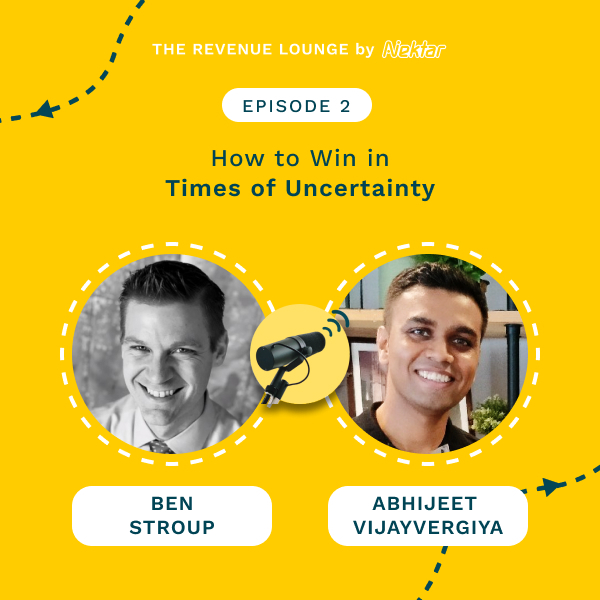
Ep #2: How to Win in Times of Uncertainty
Listen Now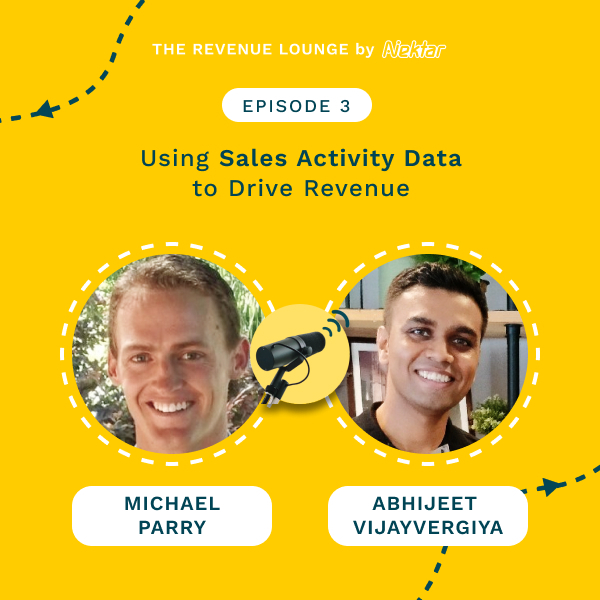
Ep #3: Using Activity Data to Drive Sales Productivity
Listen Now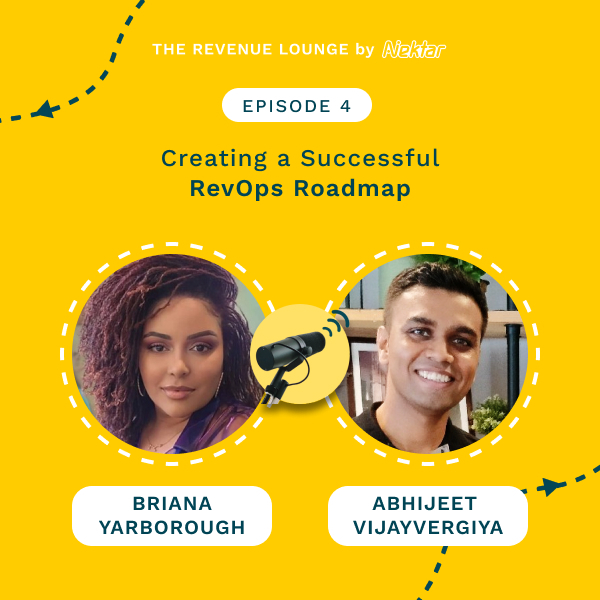
Ep #4: Creating a Successful RevOps Roadmap
Listen Now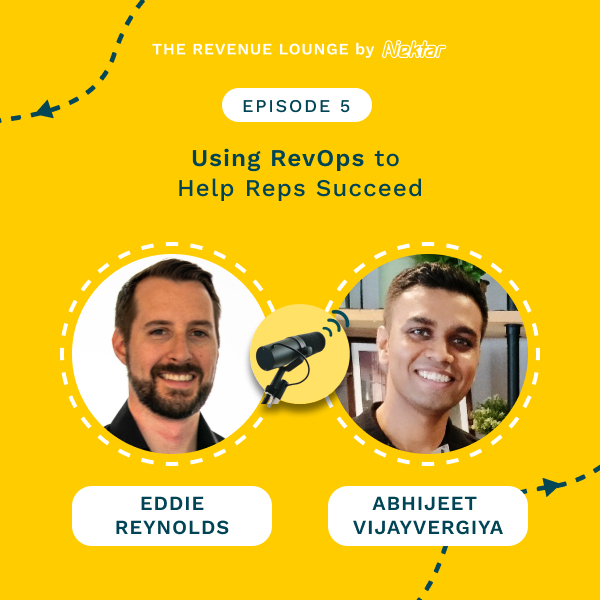
Ep #5: Using RevOps to Help Reps Succeed
Listen Now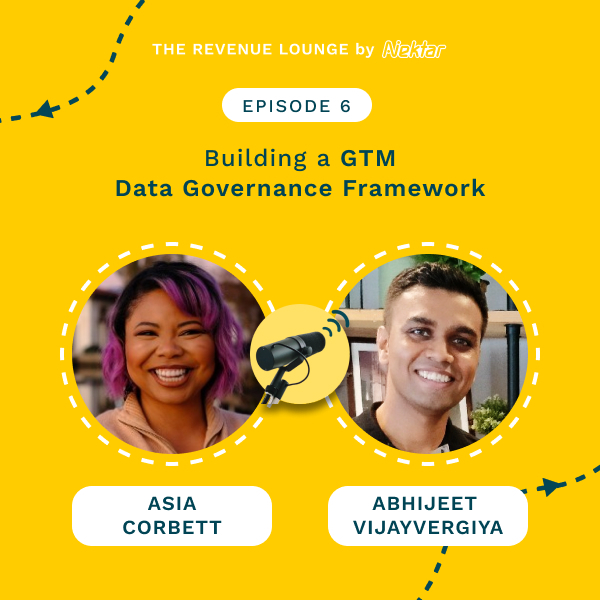
Ep #6: Building a GTM Data Governance Framework
Listen Now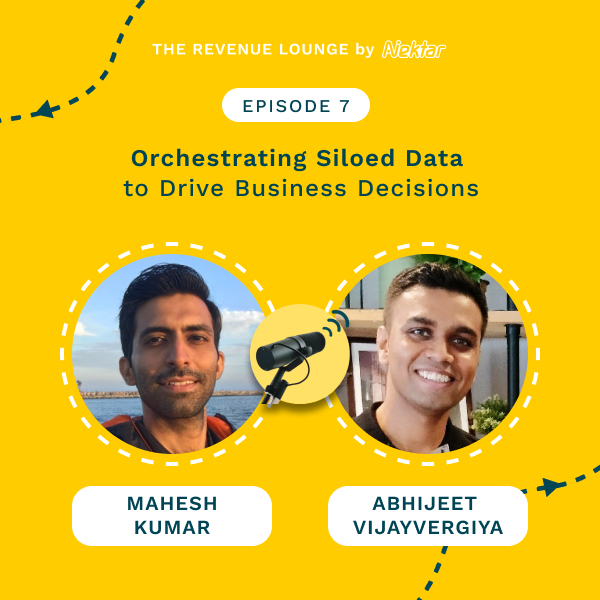
Ep #7: Orchestrating Siloed Data to Drive Business Decisions
Listen Now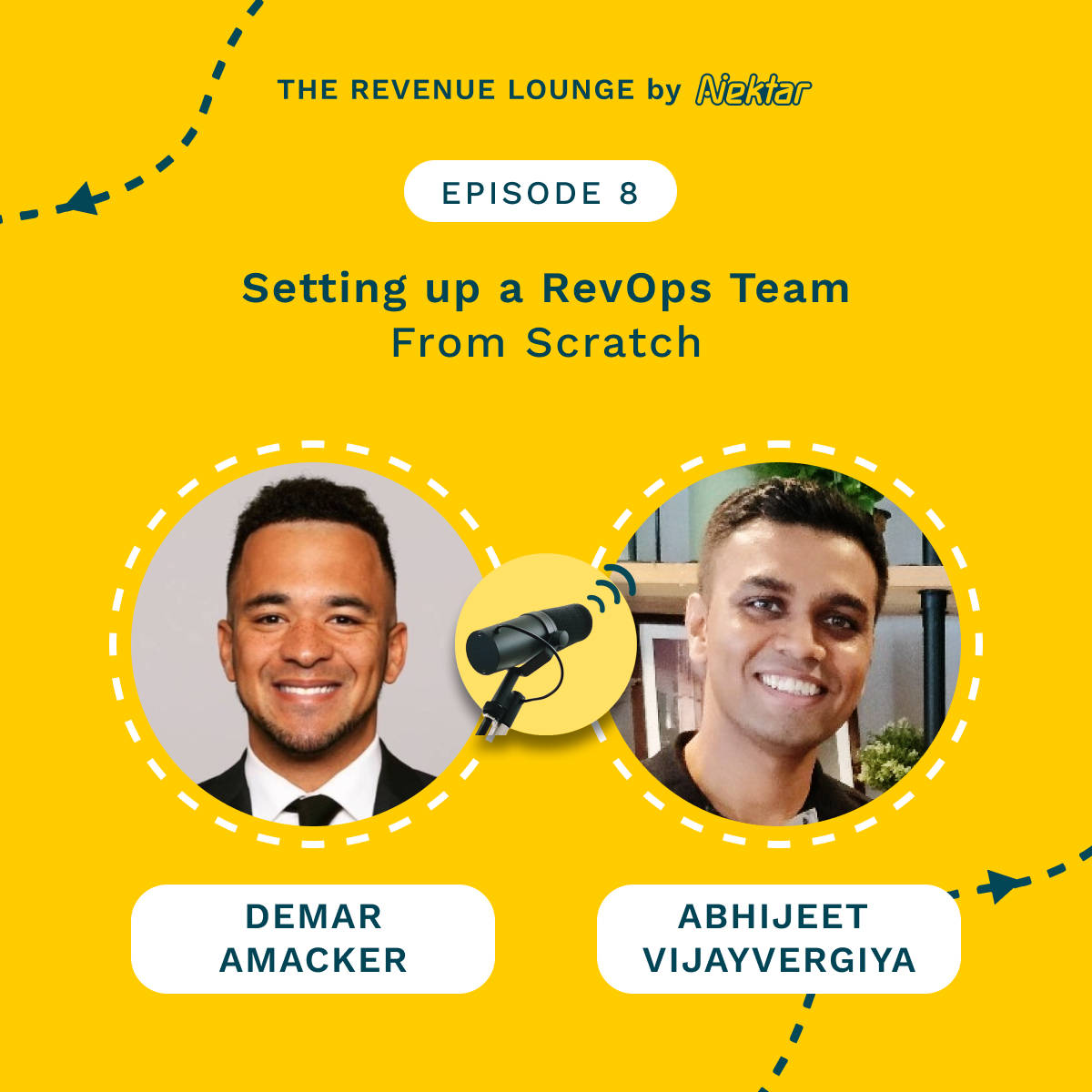
Ep #8: Setting Up a RevOps Team From Scratch
Listen Now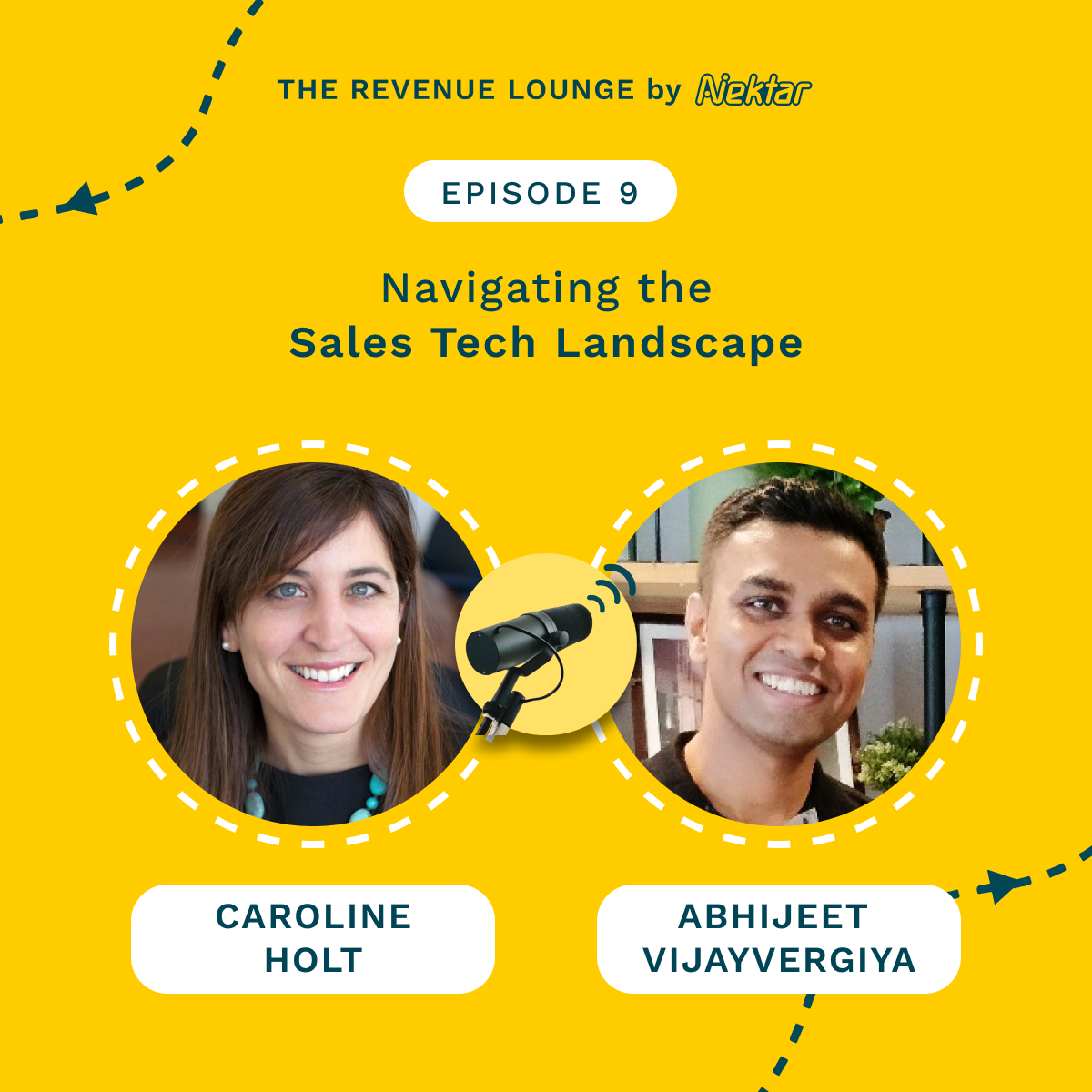
Ep #9: Navigating the Sales Tech Landscape
Listen Now